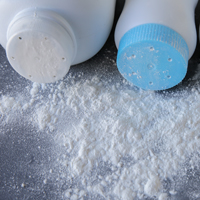The Link Between Talcum Powder and Cancer
May 9, 2018 Talcum powder, or baby powder, is a product that most people have in their medicine cabinet. In addition to other common uses, like providing relief from diaper rash, it is widely used by women as a moisture-absorbing personal hygiene powder. Few products have had a more wholesome image than Johnson’s Baby Powder, but that image is being tarnished by claims that talcum powder can cause cancer. Studies have shown that women are at an increased risk of developing ovarian cancer if they use the powder in their genital area.
Talcum powder, or baby powder, is a product that most people have in their medicine cabinet. In addition to other common uses, like providing relief from diaper rash, it is widely used by women as a moisture-absorbing personal hygiene powder. Few products have had a more wholesome image than Johnson’s Baby Powder, but that image is being tarnished by claims that talcum powder can cause cancer. Studies have shown that women are at an increased risk of developing ovarian cancer if they use the powder in their genital area.
Talcum powder is made from talc, which is a clay mineral composed mainly of magnesium, silicon, and oxygen. In its natural form, it contains smalls amounts of asbestos, which is known to cause certain types of cancers if inhaled. However, all talcum products used in the United States have been asbestos-free since the 1970s. While the link between cancer and long-term exposure to talc that contains asbestos is well-documented, considering asbestos is a known carcinogen, there is a growing concern that asbestos-free talc poses a significant cancer risk when used on the genital and perineal area.
How Talc Can Cause Cancer
According to several studies, when applied directly to the area, or applying the powder to a sanitary napkin, the powder can travel into the genital tract, making its way into the ovaries. Once in the ovaries, it can cause irritation and inflammation, which can develop into cancer over time. According to Dr. Daniel Cramer, Professor of Obstetrics and Gynecology at Brigham and Women’s Hospital in Boston, women who use talc as part of their personal hygiene have a 33 percent greater risk of developing ovarian cancer.
In 1982, Cramer published one of the first studies that examined the link between talc and ovarian cancer. In a follow up article, he urged companies like Johnson & Johnson to include warning labels on all products containing talcum powder. However, a spokesperson from the company said that there is not enough evidence to support the claim that talc causes cancer.
Research Indicating Cancer Link
The following studies have found an increased cancer risk associated with the use of talcum powder:
- In 2013, Cancer Prevention Research found that women who used talcum powder in their genital area were at an increased risk of developing epithelial ovarian cancer compared to women who never used the powder.
- A group of Harvard epidemiologists conducted a 2010 study, which found that postmenopausal women who regularly used talcum powder had a 24 percent increased risk of endometrial cancer.
- In 2003, researchers analyzed a group of 16 studies and found that women who used talcum powder on their perineum had a 33 percent increased risk of ovarian cancer.
- Both the American Cancer Society and the International Agency for Research on Cancer have found that the perineal use of talc is associated with an increased risk of cancer.
The following are examples of widely used brands of body powder that contain talc:
- Johnson & Johnson Baby Powder
- Shower to Shower Body Powder (Johnson & Johnson/Valeant)
- Gold Bond Body Powder
- Pinaud-Clubman Talcum Powder
- McKesson Baby Powder
Baltimore Medical Malpractice Lawyers at LeViness, Tolzman & Hamilton Represent Victims of Medical Negligence
If you have developed cancer after using talcum powder as part of your personal hygiene, contact the Baltimore medical malpractice lawyers at LeViness, Tolzman & Hamilton. We will examine every detail of your case and determine who is responsible for jeopardizing your health. Our dedicated and compassionate team will seek the maximum financial compensation you deserve. For a free consultation, call us at 800-547-4LAW (4529) or contact us online.
Our offices are located in Baltimore, Columbia, Glen Burnie, and Towson, allowing us to represent medical malpractice victims in Maryland, including those in Anne Arundel County, Baltimore County, Carroll County, Harford County, Howard County, Montgomery County, Maryland’s Western Counties, Prince George’s County, Queen Anne’s County, Southern Maryland, and the Eastern Shore, as well as the communities of Catonsville, Essex, Halethorpe, Middle River, Rosedale, Gwynn Oak, Brooklandville, Dundalk, Pikesville, Nottingham, Windsor Mill, Lutherville, Timonium, Sparrows Point, Ridgewood, and Elkridge.






